Kitchen lighting is an essential aspect of any home design. It can make or break the ambiance of the space, and it is important to get it right. There are a variety of kitchen lighting ideas available that can transform your space from dull to vibrant. This article will explore some of the best ideas for kitchen lighting, including lighting basics, light fixtures, task lighting, and more.
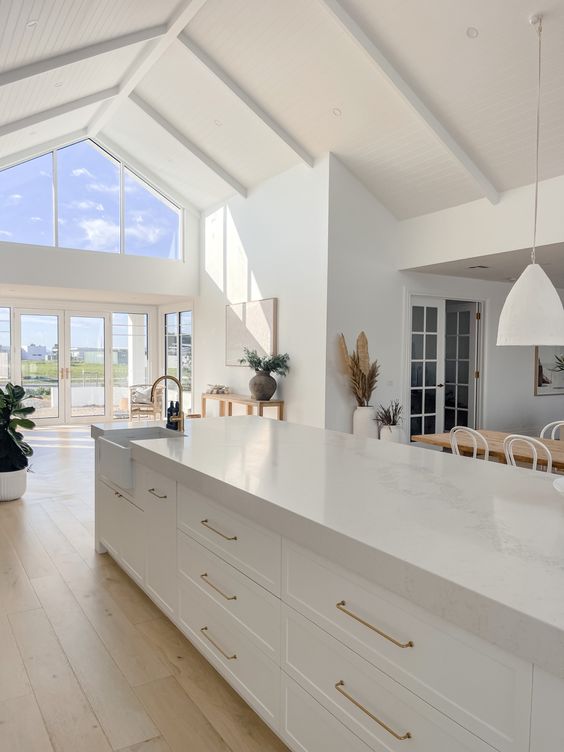
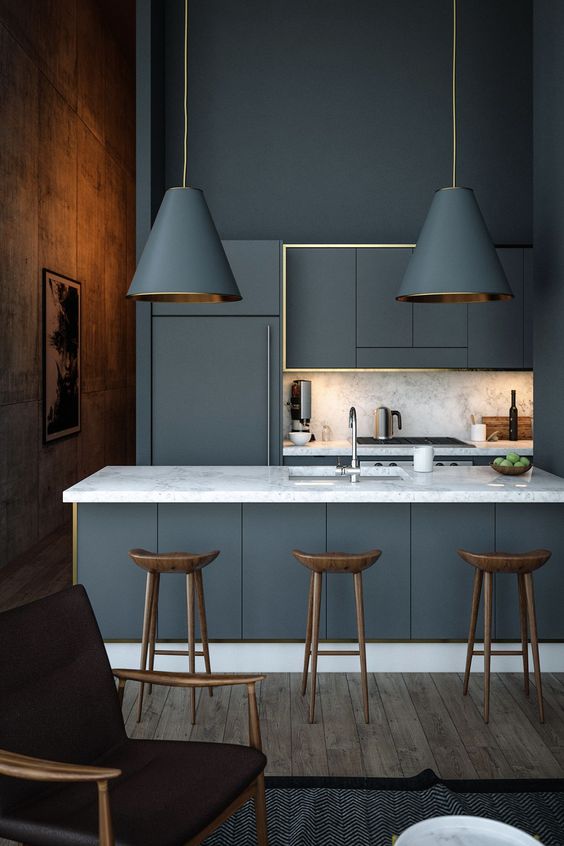
Understanding Kitchen Lighting Basics is crucial to creating an efficient and effective lighting design. It is essential to consider the size of the kitchen, the amount of natural light available, and the type of activities that take place in the space. Once these factors are considered, it is easier to determine the type of lighting fixtures and bulbs that will work best. From there, you can begin to explore the various lighting options available, including accent and decorative lighting, task lighting, and natural light integration.
Key Takeaways
- Understanding Kitchen Lighting Basics is crucial to creating an effective lighting design.
- Task lighting is essential for efficiency in the kitchen.
- Integrating natural light can enhance the ambiance of the space.
Understanding Kitchen Lighting Basics

When it comes to kitchen lighting, there are many factors to consider. From size and style to light fixtures and scale, it can be overwhelming to choose the right lighting for your space. However, understanding the basics of kitchen lighting can help you make informed decisions that will enhance the functionality and ambiance of your kitchen.
The Importance of Scale and Size
One of the most important aspects of kitchen lighting is scale and size. Choosing fixtures that are too small can make your kitchen feel cramped and dark, while choosing fixtures that are too large can overwhelm the space. It’s important to consider the size of your kitchen and the height of your ceilings when selecting fixtures. A general rule of thumb is to choose fixtures that are 12-18 inches smaller than the width of your island or table.
Choosing the Right Style for Your Kitchen


The style of your kitchen lighting should complement the overall design of your space. Whether you have a traditional or modern kitchen, there are many styles to choose from. Some popular styles include pendant lights, chandeliers, and track lighting. When selecting fixtures, it’s important to consider the color and finish of your cabinets, countertops, and backsplash to ensure a cohesive look.
Functional Layers of Kitchen Lighting
In addition to style and scale, it’s important to consider the functional layers of kitchen lighting. There are three main types of kitchen lighting: ambient, task, and mood lighting. Ambient lighting provides overall illumination for the space, while task lighting is focused on specific work areas such as the sink or stove. Mood lighting adds a decorative touch and can be used to create a warm and inviting atmosphere. By incorporating these three layers of lighting, you can create a functional and beautiful kitchen that meets all of your needs.

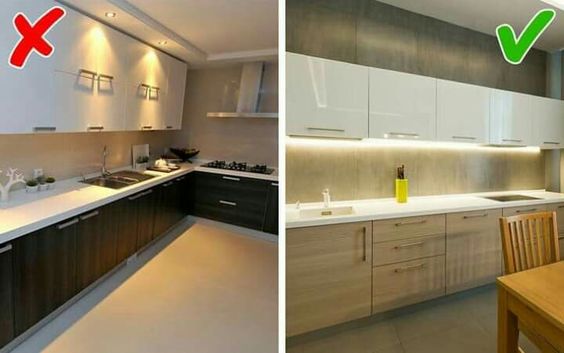
Overall, understanding the basics of kitchen lighting is essential for creating a space that is both functional and stylish. By considering factors such as scale, style, and functional layers, you can select fixtures that enhance the ambiance and functionality of your kitchen.
Designing with Light Fixtures

Light fixtures are a crucial element when it comes to designing a kitchen. They not only provide the necessary illumination for cooking and preparing food, but they also add to the overall ambiance of the space. In this section, we will explore some of the ways you can design with light fixtures in your kitchen.
Statement Lighting as a Focal Point
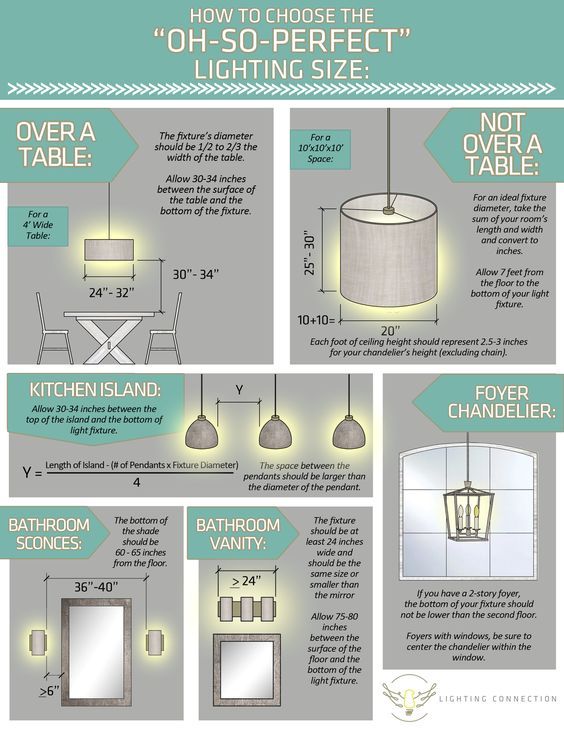
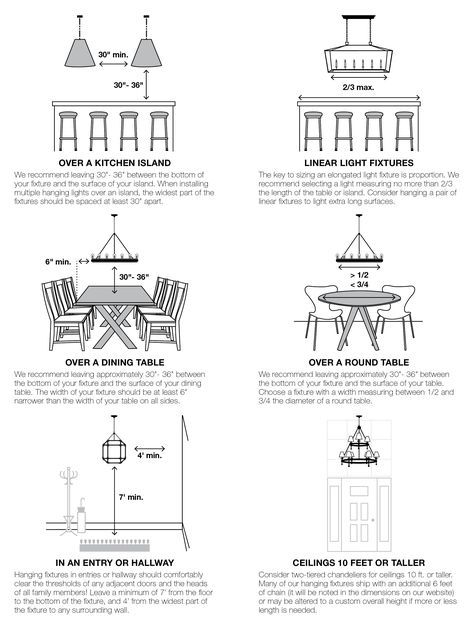
Statement lighting is a great way to add a focal point to your kitchen. Whether it’s a chandelier or a unique pendant light, statement lighting can add a touch of elegance and sophistication to your space. When choosing a statement light fixture, consider the size and style of your kitchen. A large chandelier may overwhelm a small kitchen, while a small pendant light may look out of place in a large kitchen.
Mix and Match for a Unique Look
Mixing and matching light fixtures is a great way to create a unique look in your kitchen. You can mix different styles and finishes to create a cohesive look that is both functional and stylish. For example, you can mix pendant lights with sconces or chandeliers to create a layered lighting effect.
The Role of Pendant Lighting
Pendant lighting is a popular choice for kitchen lighting. They come in a variety of styles, sizes, and finishes, making it easy to find one that fits your design aesthetic. Pendant lights can be used to provide task lighting over a kitchen island or table, or they can be used as decorative accent lighting. When choosing pendant lights, consider the height of your ceiling and the size of your space to ensure that they are the right scale for your kitchen.
In conclusion, light fixtures play a significant role in designing a kitchen. Whether you choose a statement light fixture, mix and match different styles, or opt for pendant lighting, there are many ways to create a functional and stylish kitchen with the right light fixtures.
Illuminating the Kitchen Island

When it comes to kitchen lighting, illuminating the kitchen island is crucial. It not only adds to the aesthetics of the kitchen, but it also serves as a functional space for cooking and entertaining. Here are some tips on how to choose the perfect pendant size and integrate functionality and style into your modern or contemporary kitchen island lighting.
Choosing the Perfect Pendant Size
The size of your pendant lights is important to consider when illuminating your kitchen island. The general rule of thumb is to choose a pendant that is one-third to two-thirds the size of your island. This will ensure that the pendant is proportional to the island and provides adequate lighting for the space.
Another factor to consider is the height of your ceiling. For higher ceilings, consider using larger pendants or grouping multiple pendants together to create a statement piece. For lower ceilings, smaller pendants or flush mount lighting may be a better option.
Integrating Functionality and Style
In addition to choosing the perfect pendant size, it’s important to integrate functionality and style into your kitchen island lighting. Bold and modern pendant designs can add a touch of personality to your kitchen, while also providing ample lighting for cooking and entertaining.
For added functionality, consider using pendant lighting with dimmer switches or adjustable heights. This allows you to customize the lighting to fit your needs, whether it’s bright task lighting for cooking or dimmed mood lighting for entertaining.
Overall, choosing the perfect pendant size and integrating functionality and style into your modern kitchen island lighting can elevate the look and feel of your kitchen while also providing functional lighting for everyday use.
Accent and Decorative Lighting Ideas

When it comes to kitchen lighting, it’s not just about functionality. Accent and decorative lighting can add charm and ambiance to the space. Here are a few ideas to consider:
Adding Charm with Sconces and Chandeliers
Sconces and chandeliers are a great way to add a touch of elegance and charm to your kitchen. Sconces can be installed on either side of a window or above a sink to provide a warm, inviting glow. Chandeliers, on the other hand, can be installed above a kitchen island or dining table to create a stunning focal point.
When choosing sconces or chandeliers, consider the style of your kitchen. For a traditional kitchen, a crystal chandelier or brass sconces might be the perfect fit. For a more modern kitchen, consider sleek, minimalist sconces or a geometric chandelier.
Creating Ambiance with Dimmers and Soft Light
Installing dimmer switches is an easy way to create ambiance in your kitchen. By adjusting the level of light, you can create a warm, cozy atmosphere for dinner parties or a bright, functional space for cooking.
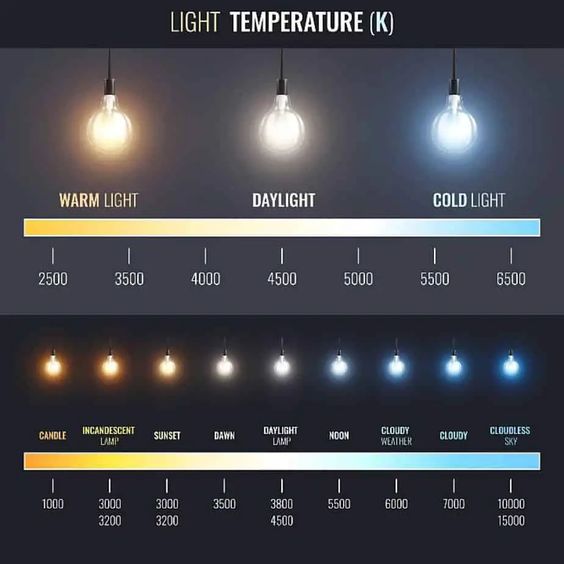

Soft light can also add ambiance to your kitchen. Consider adding under-cabinet lighting to provide a subtle glow that highlights your countertops and backsplash. You can also use candles to create a cozy, intimate atmosphere during dinner parties.
Overall, accent and decorative lighting can add personality and style to your kitchen. Whether you choose sconces, chandeliers, dimmer switches, or soft lighting, make sure to consider the overall style of your kitchen and the atmosphere you want to create.
Task Lighting for Efficiency

One of the most important factors to consider when designing kitchen lighting is task lighting. Task lighting is essential for creating a functional and efficient kitchen. It helps to illuminate work areas, making it easier to prepare food, cook, and clean up. In this section, we will explore some of the best task lighting solutions for your kitchen.
Under-Cabinet Lighting Solutions
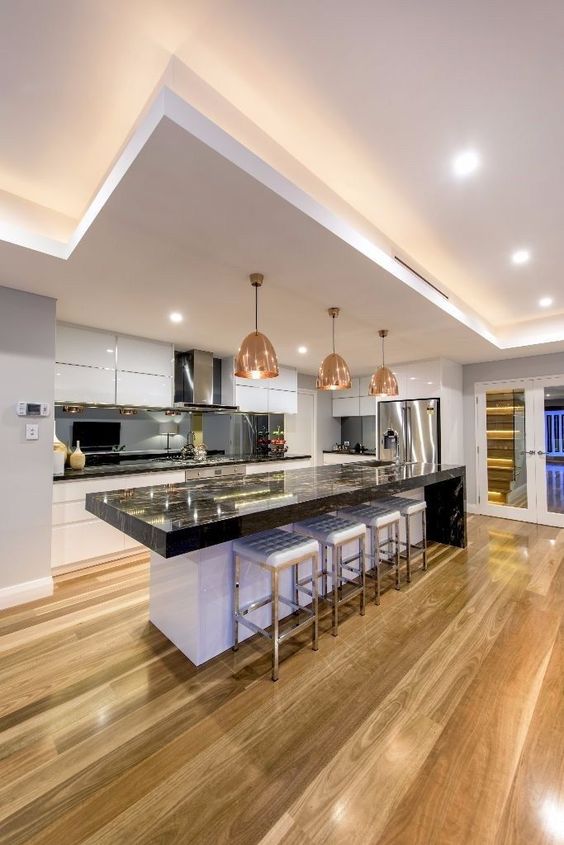

Under-cabinet lighting is a popular choice for task lighting in the kitchen. It provides direct light to work surfaces, making it easier to see what you are doing. There are several types of under-cabinet lighting solutions available, including LED strips, puck lights, and linear lights.
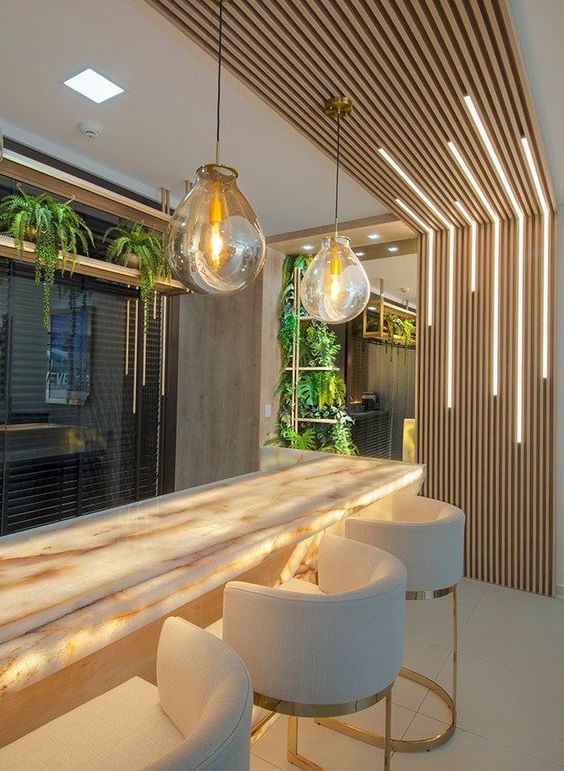
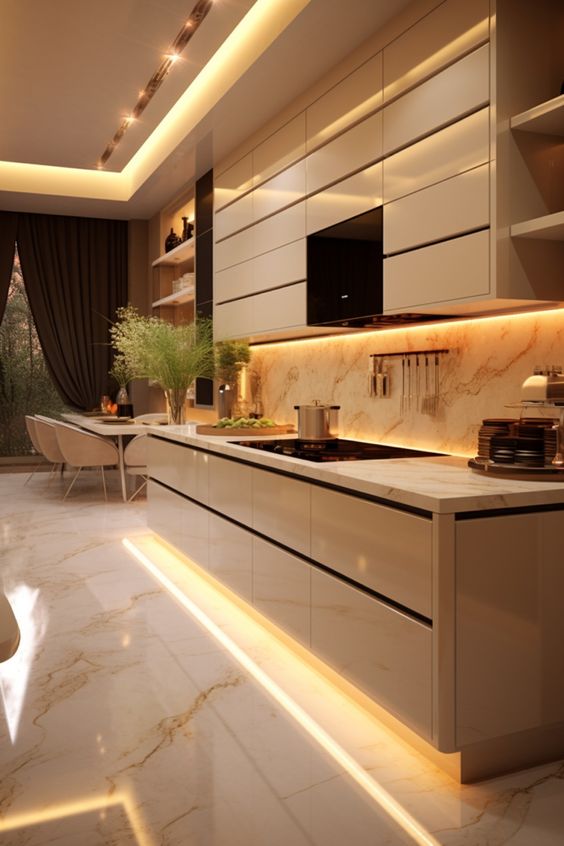
LED strips are a great option for under-cabinet lighting. They are easy to install and provide bright, even light. Puck lights are another option, and they are ideal for highlighting specific areas, such as the stove or sink. Linear lights are a more modern option and provide a sleek, minimalist look.
Brightening Work Areas with Downlights
Downlights are another popular option for task lighting in the kitchen. They provide a bright, focused beam of light, making them ideal for illuminating work areas. There are several types of downlights available, including recessed downlights, track lighting, and pendant lights.
Recessed downlights are a popular choice for kitchen lighting. They provide a clean, minimalist look and are perfect for illuminating work areas. Track lighting is another option and allows you to direct light where you need it most. Pendant lights are a more decorative option and can add a touch of style to your kitchen.
In conclusion, task lighting is an essential element of any kitchen lighting design. Under-cabinet lighting and downlights are two of the best task lighting solutions for your kitchen. By incorporating these lighting solutions into your kitchen design, you can create a functional, efficient, and stylish space.
Natural Light Integration

When it comes to kitchen lighting ideas, natural light integration can be a game-changer. Not only does it save energy, but it can also create a warm and inviting atmosphere in the kitchen. Here are some tips for maximizing natural light in kitchen design.
Maximizing Daylight in Kitchen Design
One of the easiest ways to maximize natural light in the kitchen is to install large windows or skylights. This will flood the space with natural light, making the kitchen feel brighter and more open. If privacy is a concern, consider installing frosted or tinted glass.
Another way to maximize natural light is to choose light-colored finishes for the kitchen. Light-colored cabinets, countertops, and backsplashes will reflect light and make the space feel brighter. Similarly, choosing light-colored flooring can help to bounce light around the room.
Blending Artificial and Natural Light
While natural light is great, it’s not always available. That’s why it’s important to have a good artificial lighting plan in place. When designing the kitchen, consider installing a combination of overhead lighting, task lighting, and accent lighting. This will ensure that the kitchen is well-lit no matter the time of day.
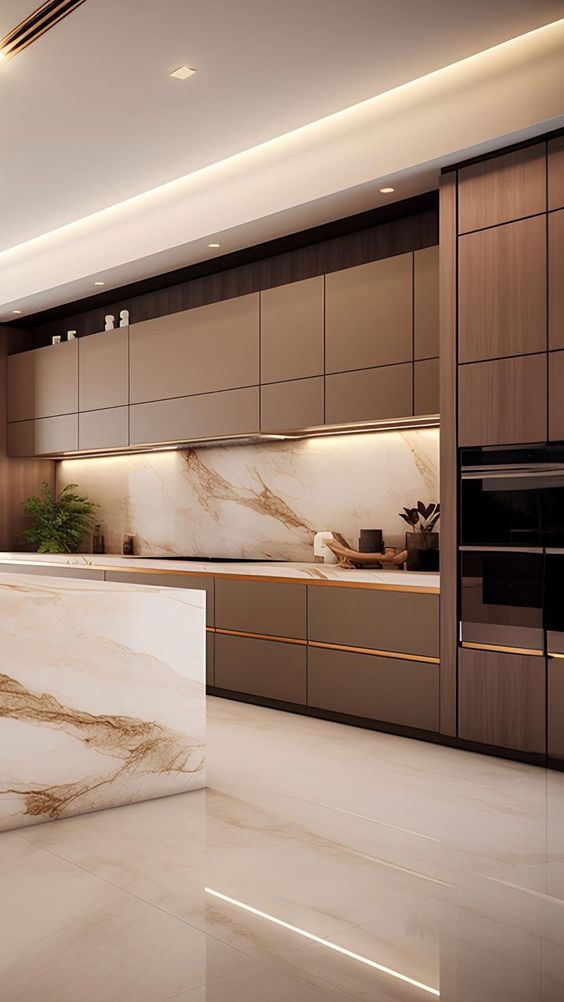
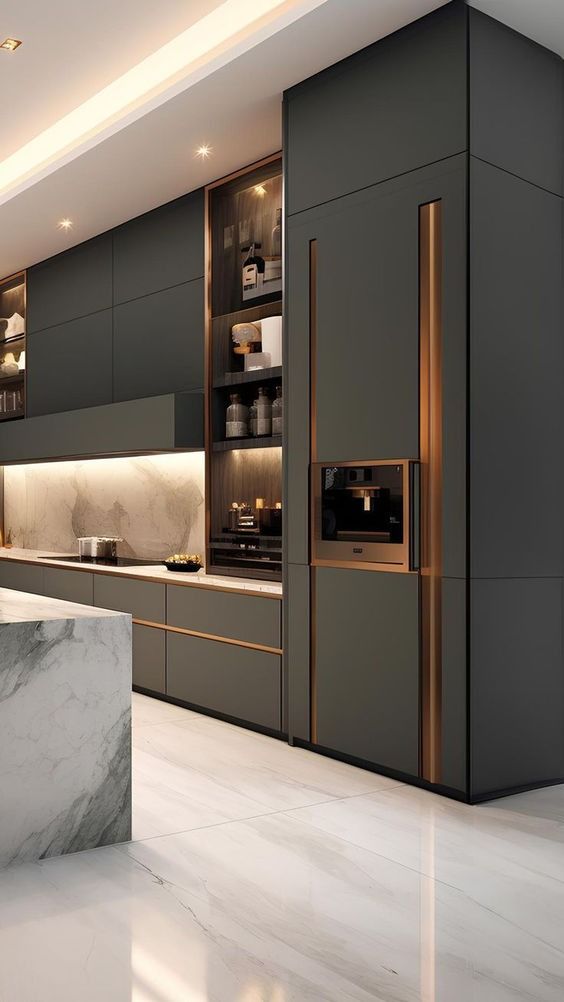
To blend artificial and natural light, consider installing dimmer switches. This will allow you to adjust the lighting throughout the day, depending on how much natural light is available. For example, in the morning, you may want brighter lighting to help wake you up, while in the evening, you may want softer lighting to create a cozy atmosphere.
In conclusion, natural light integration is an important consideration when designing a kitchen. By maximizing daylight and blending artificial and natural light, you can create a bright and inviting space that is both functional and beautiful.
Lighting for Small and Large Kitchens

When it comes to kitchen lighting, the size of your kitchen plays a significant role in determining the right lighting strategy. A well-lit kitchen can make meal prep and cooking more comfortable and enjoyable. Here are some lighting ideas for small and large kitchens.
Adjusting Lighting Scale to Kitchen Size
The scale of lighting fixtures should match the size of your kitchen. In small kitchens, it’s best to use small and compact light fixtures that won’t overpower the space. Larger kitchens, on the other hand, require bigger fixtures to provide adequate lighting. A general rule of thumb is to use one fixture for every 50 square feet of kitchen space.
Strategies for High and Low Ceilings
Ceiling height is another factor to consider when choosing kitchen lighting. High ceilings can accommodate larger fixtures or pendant lights, which can add drama and style to the kitchen. Low ceilings, on the other hand, require low-profile fixtures such as recessed lighting or flush-mount fixtures.
For kitchens with high ceilings, consider installing track lighting or pendant lights to provide task lighting over the kitchen island or dining area. In kitchens with low ceilings, recessed lighting can provide even and bright light without taking up valuable headspace.
In conclusion, the right lighting strategy can make a significant difference in the look and functionality of your kitchen. By adjusting the scale of lighting fixtures to the size of your kitchen and considering the ceiling height, you can create a well-lit and inviting space for cooking and entertaining.
Innovative Lighting Styles

When it comes to kitchen lighting, there are many innovative styles that can elevate the overall look and feel of your space. Here are a few ideas to consider:
Modern and Minimalist Approaches
For those who prefer a sleek and contemporary look, modern and minimalist lighting styles are the way to go. Think clean lines, simple shapes, and neutral colors. Pendant lights with geometric shapes or linear chandeliers can add a touch of modern elegance to any kitchen. LED strip lighting under cabinets or along the ceiling can also create a cool and modern vibe.


Rustic and Farmhouse Trends


If you’re going for a cozy and inviting feel in your kitchen, rustic and farmhouse lighting styles are perfect. Think warm metals like copper and bronze, and natural materials like wood and rope. Lantern-style pendant lights or chandeliers with exposed bulbs can add a rustic touch, while mason jar pendant lights or wire basket fixtures can give off a farmhouse vibe.
Retro and Midcentury Influences

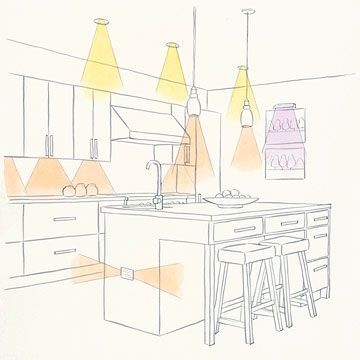
For those who love a vintage feel in their kitchen, retro and midcentury lighting styles are a great option. Think bold colors, funky shapes, and metallic finishes. Sputnik chandeliers or pendant lights with colorful glass shades can add a retro touch, while globe pendant lights or atomic-style fixtures can give off a midcentury vibe.
No matter what style you choose, innovative lighting can transform your kitchen into a stylish and functional space.
Decorative Elements and Materials

When it comes to kitchen lighting, decorative elements and materials can play a significant role in enhancing the overall look and feel of the space. Here are some ideas for incorporating decorative elements and materials into your kitchen lighting design.
Metallic and Glass Accents


For an elegant touch, consider incorporating metallic and clear glass accents into your kitchen lighting. Pendant lights with metallic finishes such as chrome or brass can add a touch of sophistication to your space. Clear glass shades can also create a sleek and modern look, while allowing the light to shine through unobstructed.
The Appeal of Rattan and Whimsical Designs
If you’re looking for a more whimsical or natural feel, consider rattan pendants or fixtures with unique and playful designs. Rattan is a versatile material that can add warmth and texture to your kitchen lighting. Whimsical designs such as animal-shaped fixtures or colorful shades can add a touch of fun and personality to your space.
Incorporating decorative elements and materials into your kitchen lighting design can help create a cohesive and stylish look. Whether you prefer elegant metallic finishes or playful rattan pendants, there are plenty of options to choose from.
Final Considerations

When it comes to kitchen lighting, there are a few final considerations to keep in mind. The right lighting can make all the difference in creating a functional and stylish space. Here are some factors to consider before making your final decisions.
The Impact of Color and Light Quality
The color and quality of light can have a significant impact on the look and feel of your kitchen. Warm light can create a cozy and inviting atmosphere, while cool light can make a space feel more modern and sleek. It’s important to choose a color temperature that complements your kitchen’s color scheme and overall aesthetic.


In addition to color temperature, consider the quality of light. High-quality LED bulbs can provide bright, natural-looking light that is ideal for cooking and preparing meals. They also use less energy and last longer than traditional incandescent bulbs.
Energy Efficiency and Sustainable Choices
When choosing kitchen lighting, it’s important to consider energy efficiency and sustainability. LED bulbs are a great choice for energy efficiency, as they use significantly less energy than traditional bulbs and last much longer. Look for bulbs with the ENERGY STAR label to ensure you’re getting the most efficient option.
For a more sustainable option, consider using natural light. Maximizing natural light can not only reduce your energy usage, but also provide a bright and inviting atmosphere. If your kitchen doesn’t have many windows, consider adding a skylight or sun tunnel to bring in more natural light.
Overall, the right kitchen lighting can make a big impact on the functionality and style of your space. By considering factors like color temperature, light quality, energy efficiency, and sustainability, you can create a kitchen that is both practical and beautiful. Whether you’re looking for a statement light fixture or understated lighting that highlights your kitchen’s focal points, there are plenty of kitchen lighting ideas to choose from.
Frequently Asked Questions

What are some innovative small kitchen lighting solutions?
Small kitchens can benefit from a variety of lighting solutions that maximize space and functionality. Consider using under-cabinet lighting or track lighting to provide ample illumination without taking up valuable counter or cabinet space. Pendant lights or mini chandeliers can also add a touch of style and elegance to a small kitchen.
How can I choose the best ceiling lighting for my kitchen?
When choosing ceiling lighting for your kitchen, consider the size and layout of the room. A larger kitchen may require multiple fixtures or a larger central fixture, while a smaller kitchen may only need one or two smaller fixtures. Additionally, consider the style of your kitchen and choose a fixture that complements the overall design aesthetic.
What are the latest trends in modern kitchen lighting design?
Modern kitchen lighting design trends include the use of natural materials, such as wood or stone, in light fixtures. Additionally, incorporating smart lighting technology, such as dimmer switches or voice-activated controls, can add convenience and energy efficiency to your kitchen.
Could you suggest some ideas for lighting over the kitchen sink?
Lighting over the kitchen sink should be functional and provide ample illumination for tasks such as dishwashing or food preparation. Consider installing a pendant light or a small track lighting system to provide targeted lighting in this area.
What are the key considerations for proper kitchen illumination?
Proper kitchen illumination should provide ample light for cooking, cleaning, and other tasks, while also creating a warm and inviting atmosphere. Consider the placement and type of lighting fixtures, as well as the color temperature of the bulbs used, to achieve optimal illumination.
Where can I find inspiration for unique kitchen lighting arrangements?
There are many sources of inspiration for unique kitchen lighting arrangements, including design magazines, online blogs, and social media platforms such as Pinterest or Instagram. Additionally, working with a professional lighting designer can help you create a truly customized and unique lighting plan for your kitchen.
- 1.5Kshares
- Facebook0
- Pinterest1.5K
- Twitter0
- Reddit0



